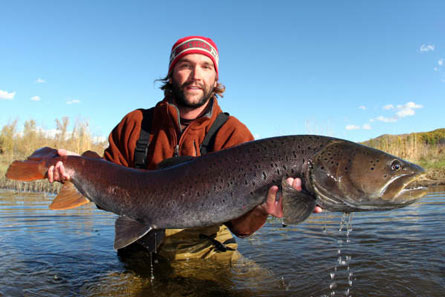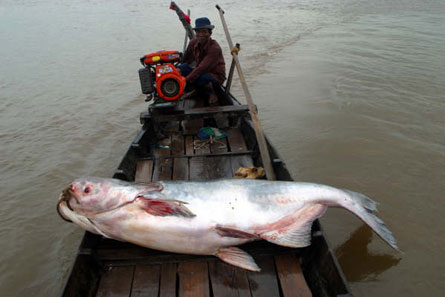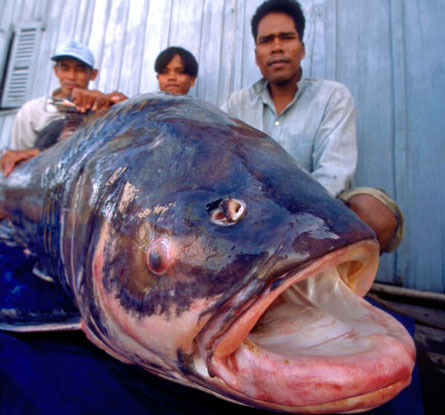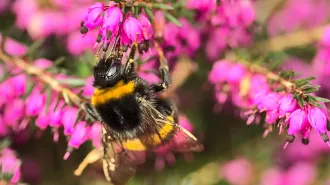Megafish Sleuth: No Steve Irwin
Yesterday I wrote about meeting Zeb Hogan, the megafish sleuth. Later, I went home and watched his televised hunt for the elusive 1,000-pound giant stingray. The National Geographic channel appears to be grooming this conservation biologist as the next wildlife adventurer. Sort of its version of a Steve Irwin for the life aquatic.



But Hogan’s no Steve Irwin. And at least for me, that’s not a bad thing.
Don’t get me wrong, I loved watching Irwin’s adventurous exploits. Especially his wrangling big vipers, which could elicit nail-biting tension. And after his death from too close an encounter with a big stingray, we now know those thrilling exploits were anything but safe, staged pseudo-drama.
But Irwin was no scientist. Australia’s beloved “crocodile hunter” adored reptiles and other misunderstood creatures, and communicated his respect for them throughout his dashing exploits. A consummate showman who commanded a huge television audience, this self-styled conservationist proved an effective communicator about the value of ecosystems and the integral role that snakes, crocs and other scary critters play in nature’s grand scheme.
Hogan, by contrast, is a scientist on the faculty of the University of Nevada, Reno. Not quite the showman that Irwin was — at least not yet — Hogan takes a more measured, educational approach to explaining why he loves the critters he studies, why they’re important — and what gaps in knowledge may preclude protecting them and the ecosystem functions they perform. He illustrates some of his data gathering during hour-long TV segments that offer a taste for field work, which in his case can be anything but tame affairs — and carried out in potentially harrowing environments.
By inviting us along, Hogan shows a new generation that science is not all lab coats and theorems. Some researchers get their feet wet — and the rest of their bodies too — in the pursuit of knowledge. And practical knowledge at that.
Hogan is trying to assess the population size and health of little-studied species, often in parts of the world where all too many rivers are still treated like sewers. The megafish that National Geo funds him to study — animals at least six-feet long or weighing at least 200 pounds — may be more charismatic than a two-inch darter, but Hogan actually cares about these Lilliputian fish as well.
All contribute to the biodiversity of freshwater systems, which Hogan maintains are in crisis globally.
He pointed me to a 2005 paper by David Dudgeon of the University of Hong Kong and his colleagues which reports that although fresh water covers only 0.8 percent of Earth’s surface, it’s home to some six percent of all known species. Yet lakes and streams “may well be the most endangered ecosystems in the world,” Dudgeon’s team notes, owing to human impacts: notably overfishing, chemical runoff or effluents from land activities, flow alterations, habitat modification and “pollution” with nonnative species. Their paper concludes that in North America alone, extinction rates for aquatic mussels, crayfishes, fish and amphibians may “be as much as four percent per decade — five times higher than species losses calculated from any terrestrial habitat.”
In their own work, Hogan and his colleagues have correlated fish size with imperiled status in both marine and freshwater ecosystems. Their 2007 analysis covered nearly 28,000 species and found that in saltwater environments, larger fish proved more vulnerable to risk of extinction — largely because they were targeted by fishers. In freshwater systems, however, where pollution, habitat destruction and river-flow alterations pose substantial risks, species threatened with extinction “tend to be smaller-bodied representatives of the global species pool.” Like those tiny darters.
That’s a general trend. For individual species, however, this trend may not hold: such as for slow growing, slowly maturing fish threatened by overfishing — especially those that bear few young at a time. Like giant stingrays.
Conservation biologists are teasing out such caveats. And some, like Hogan, are even receiving a video forum to share their findings in near real-time.
Science seldom yields simple, black-and-white answers. Which is why I applaud National Geo for engaging scientists to explain natural science — and the caveats that define it — to the public. And maybe if some of them can adopt the Steve Irwin (heck, Indiana Jones) action-hero persona, they might make science more exciting — and a sustaining career goal — for an increasing number of youngsters.
See also yesterday’s blog: Monster stingrays: Field notes from a global wrangler






